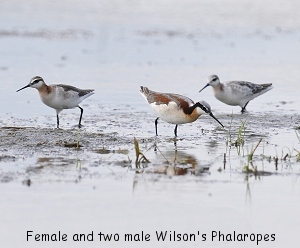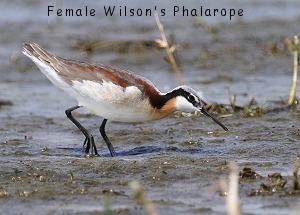The Wilson's Phalarope
By Gord Gadsden
July 1, 2008
This little shorebird with a fascinating life history is an uncommon migrant in our area during spring  and fall migration. Wintering on the western side of South America in shallow lakes, most travel north to breed in marshes and wet meadows in the interior of the Province. They are also found through the Prairies in similar habitat. Watch for them in flooded fields and in shallow lakes and ponds in our area. and fall migration. Wintering on the western side of South America in shallow lakes, most travel north to breed in marshes and wet meadows in the interior of the Province. They are also found through the Prairies in similar habitat. Watch for them in flooded fields and in shallow lakes and ponds in our area.
Visually, this shorebird is deceptive. Usually in the bird world males are larger and more colourfully plumaged than females. However, this is not always the case and this holds true for the three phalarope species found in North America. The female sports a striking colouration while the males are much duller.
Their abnormality does not stop there. Like their colouration, their breeding roles are also reversed. Females fight for territory and for males which she will court by using an array of displays. After the female lays the eggs, she will often leave the male to incubate and then raise the young. Occasionally, in the cases where she has left the male, she will even find another male and repeat the process. Females fight for territory and for males which she will court by using an array of displays. After the female lays the eggs, she will often leave the male to incubate and then raise the young. Occasionally, in the cases where she has left the male, she will even find another male and repeat the process.
Baby Wilson's Phalaropes, like all shorebirds, are born able to follow their parent(s) and to find their own food under the adult's watchful eye. Wilson's Phalaropes eat a variety of small aquatic creatures including spiders and insects. Aquatic plant seeds are also consumed. They catch their food from along shore and when wading in the shallows. When in deeper water they can swim with help from their very dense plumage and lobed feet. When feeding in deeper water, they spin like tops, doing up to 60 revolutions per minute while picking food from the water. When in deeper water, they spin like tops, doing up to 60 revolutions per minute while picking food from the water. This action likely causes food items lying on the bottom of the pond to rise so it can be reached by the phalarope that probably finds it difficult to dabble under the water with its dense plumage and thus does not often do it. Wilson's Phalaropes like to feed communally with other species of bird especially Northern Shovelers. It has been noted that the phalarope's feeding efficiency triples when feeding behind Northern Shovelers. I suspect that the shovelers must somehow cause food preferred by the Wilson's Phalarope to be more readily available by their disturbing the pond bottom with their bigger feet and bills.

Links and sources:
Ehrlich, Dobkin and Wheye, (1988)
Sibley, D. (2000) |